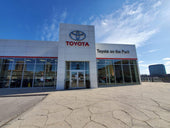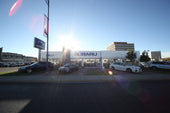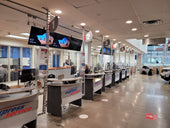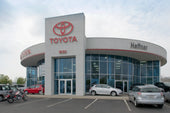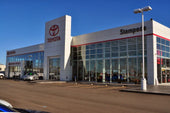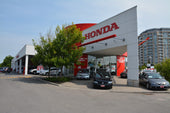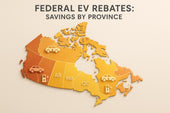Understanding the difference between invoice price and dealer fees can help you save money when buying a car in Canada. The invoice price is what the dealer pays the manufacturer for the vehicle, often lower than the MSRP (Manufacturer’s Suggested Retail Price). Dealer fees, on the other hand, are extra charges added by the dealership, such as documentation fees or freight charges. Here's a quick breakdown:
- Invoice Price: Dealer's cost, typically 5–15% below MSRP. Can include hidden perks like holdbacks or cash incentives, reducing the dealer’s actual cost further.
- Dealer Fees: Additional charges like admin fees, freight, and optional add-ons. Some fees are mandatory (e.g., taxes), while others can be negotiated.
Quick Comparison
| Attribute | Invoice Price | Dealer Fees |
|---|---|---|
| Set By | Manufacturer | Dealership |
| Negotiability | High | Some negotiable, others fixed |
| Purpose | Base vehicle cost | Covers paperwork, delivery, services |
| Range | 5–15% below MSRP | $300–$1,000+ |
To negotiate effectively, start with the invoice price and ask about hidden dealer incentives. For fees, request an itemized breakdown to identify mandatory vs. optional charges. This approach can save you hundreds or even thousands of dollars.
Invoice Price: How It Works
How Invoice Price is Set
The invoice price represents what a dealership pays the manufacturer for a vehicle. This includes the base cost and any factory-installed options. However, what’s included in this figure can vary depending on the manufacturer and even the province where the purchase is made.
For example, fees like freight, destination charges, and pre-delivery inspection (PDI) might be bundled into the invoice price - or they could be listed separately. To avoid surprises, it’s a good idea to ask for a detailed breakdown of what’s included. This can help you better understand the numbers and avoid confusion.
Manufacturers determine the invoice price through agreements with dealerships, and several factors play into this calculation. Market demand, production costs, and promotional strategies all influence the final figure. During times of high demand or limited inventory, invoice prices tend to be less flexible. On the other hand, when manufacturers want to clear out specific models, promotions may push prices closer to - or even below - the invoice price. Next, let’s unpack the hidden incentives that can further reduce what dealers actually pay.
Hidden Dealer Incentives and Discounts
The invoice price doesn’t tell the whole story - it doesn’t reflect the dealer’s true net cost. Why? Because manufacturers often provide hidden financial perks that reduce the dealer’s actual expenses.
One of the most common incentives is the dealer holdback. This is typically 2–3% of the MSRP or invoice price, which the manufacturer reimburses to the dealer after the sale. For instance, if a vehicle has an MSRP of $40,000 CAD, a 2% holdback means the dealer gets an $800 CAD rebate after selling the car. This effectively lowers their real cost.
In addition to holdbacks, manufacturers may offer dealer cash incentives - lump-sum payments aimed at boosting sales of specific models. Dealers can also earn volume bonuses for hitting monthly or quarterly sales targets. And while manufacturer-to-consumer rebates are often passed through the dealer, these aren’t always reflected in the invoice price.
These hidden incentives explain why some skilled negotiators manage to secure deals below the invoice price. Even when it seems like the dealer is cutting into their profit margin, they’re often still earning thanks to these behind-the-scenes benefits.
Using Invoice Price for Negotiation
Think of the invoice price as your starting point for negotiations - not the final number. Since dealers benefit from extra incentives and discounts, their actual costs are often lower than the invoice figure. This means you have room to negotiate.
When reviewing the dealer invoice, ask for a breakdown of the base price, options, and included fees. Questions like, “Are there holdbacks or dealer cash incentives for this model?” show that you understand the system and can lead to better offers.
Armed with this knowledge, you can approach negotiations with confidence. By asking about hidden incentives like holdbacks and dealer cash, you can aim for a price closer to the dealer’s true cost. Even if you settle on a price at or slightly below the invoice, keep in mind that the dealer is likely still profiting from these additional perks.
To simplify this process, platforms like Price Driven offer transparent access to dealer costs, including hidden incentives and factory discounts that don’t appear on standard invoices. Instead of spending hours researching, you can quickly see a vehicle’s actual dealer cost, empowering you to negotiate smarter.
"Knowing how much discount there is, helps with negotiating the price." – Michael S, Vancouver, BC
Understanding invoice pricing and hidden incentives puts you in a strong position for negotiation. Just remember, fees like administration, documentation, and government taxes aren’t part of the invoice price and will be added to your final cost.
Dealer Fees: Types and Negotiation
Common Dealer Fees in Canada
When buying a car, the negotiated price is just the beginning. Dealer fees can quickly add up, so knowing what to expect can help you avoid surprises when you sign the paperwork.
Administration fees - sometimes called documentation or doc fees - are one of the most common charges. These cover costs like processing paperwork, registering the vehicle, and handling licence plates. In Canada, administration fees usually range from $200 to $800 CAD, but some dealers may charge more. The good news? These fees are often negotiable.
Freight and PDI (Pre-Delivery Inspection) charges are set by manufacturers to cover transportation and inspection costs before delivery. These fees typically fall between $1,600 and $2,200 CAD for new vehicles. In some provinces, manufacturers are required to include freight charges in the advertised MSRP, so practices can vary depending on where you live.
Add-on products and services - like extended warranties, rustproofing, fabric protection, and dealer-installed accessories - are another category of fees. Costs for these can vary widely. For example, extended warranties may cost $1,500 to $3,000 CAD, while fabric protection might range from $200 to $500 CAD. Unlike other fees, these add-ons are entirely optional.
Let’s break it down with an example: A buyer purchasing a vehicle with an MSRP of $35,000 CAD could see an additional $2,000 CAD for freight/PDI, $600 CAD for administration, and $1,500 CAD for add-ons like an extended warranty. Without careful review, these fees could inflate the price to $39,100 CAD before taxes.
Understanding which fees are mandatory and which are negotiable can help you control costs - something we’ll explore next.
Required vs. Optional Fees
Knowing which fees are fixed and which are up for negotiation is key to navigating dealer charges. Not all fees are created equal, and understanding their nature can give you an edge during negotiations.
Legally required fees include charges like freight/PDI (set by manufacturers), provincial sales tax (PST), federal goods and services tax (GST), and government licensing and registration fees. These are non-negotiable, though their amounts can vary by province.
Negotiable fees often include administration or documentation charges. While legal, these fees aren’t strictly regulated in all provinces, giving dealers some leeway in what they charge. If you’re hit with an administration fee over $800 CAD, it’s worth questioning. Some manufacturers even impose limits on these fees.
Optional fees cover extras like extended warranties, protection packages, and dealer-installed accessories. These are entirely up to you. Dealers may present these add-ons as standard, but you’re under no obligation to accept them.
Provincial laws also come into play. For instance, in Ontario, administration fees aren’t regulated, but dealers must clearly disclose all charges. In Quebec, certain fees may be capped. Reviewing your province’s consumer protection laws can help you understand your rights before stepping into a dealership.
Reading the Fine Print
Once you’ve familiarized yourself with the types of fees, it’s time to dig into the fine print. Careful review of the details can help you spot hidden or duplicate charges and avoid overpaying. Transparency is key to effective negotiations.
Always request a full, itemized cost breakdown. This should clearly list each fee, its amount, and its purpose. If anything seems unclear or excessive, ask for an explanation.
For example, if you’re quoted a $1,000 CAD administration fee - well above the typical range - challenge it. You might negotiate it down to $400 CAD, saving yourself $600 CAD. If a dealer refuses to explain or justify their fees, they may be inflating costs unnecessarily.
Reputable dealers will provide clear explanations for all charges and won’t pressure you into accepting fees you don’t understand. If a dealer resists giving you a detailed breakdown, consider it a red flag.
Failing to carefully review dealer fees can lead to paying much more than you need to. Inflated administration fees, unnecessary add-ons, and duplicate charges can all drive up the final cost of your vehicle. Don’t let these fees go unchecked - your wallet will thank you.
Invoice Pricing Should You Believe It? Does It Even Matter? Dealers Love To Use This Tactic!
sbb-itb-20f5d75
Main Differences Between Invoice Price and Dealer Fees
Knowing the distinction between invoice price and dealer fees is key to making informed car-buying decisions. These two cost factors play different roles in the pricing process and can significantly influence your ability to negotiate.
Comparison Table: Invoice Price vs. Dealer Fees
| Attribute | Invoice Price | Dealer Fees |
|---|---|---|
| Nature | Base cost of the vehicle | Extra charges added by the dealership |
| Set By | Manufacturer | Dealership |
| Negotiability | Highly negotiable | Some negotiable, others fixed |
| Typical Range | 5–15% below MSRP | Around $300 to over $1,000 CAD |
| Visibility | Not always disclosed upfront | Should be itemized at sale |
| Purpose | Represents vehicle cost and options | Covers admin costs and additional services |
| Varies by Dealer | Yes, due to manufacturer incentives | Yes, depending on dealer and provincial rules |
The biggest difference lies in negotiability. The invoice price often provides a strong starting point for negotiations because it reflects the dealer's cost - though this cost may be further reduced by hidden manufacturer incentives. Dealer fees, on the other hand, can be partially negotiable, but some are fixed or regulated by provincial laws.
This breakdown highlights how each cost factor impacts your overall deal, helping you understand how they come together to shape the final price.
How Both Create the Final Price
When calculating the final price of a vehicle, these components stack up in layers. The process starts with the negotiated vehicle price, typically based on the manufacturer's suggested retail price (MSRP) and adjusted downward using the invoice price as leverage. Once the vehicle price is settled, dealer fees and mandatory taxes are added to determine the total cost. Knowing these layers gives you a clear roadmap for identifying areas where you can negotiate and save money.
Why Buyers Need to Know Both
Understanding both the invoice price and dealer fees equips you with the knowledge to negotiate more effectively. This insight ensures you can assess the true cost of a vehicle and avoid surprises from unexpected charges. Always question fees that seem unusually high or exceed typical ranges.
Market conditions can also influence your deal. During periods of high demand, vehicles tend to sell closer to MSRP, leaving less room to negotiate on the vehicle price. However, dealer fees often remain open to negotiation, offering a potential opportunity to lower costs regardless of market trends.
Ultimately, being informed about these pricing components puts you in a stronger position. Recent data shows that buyers using transparent pricing tools saved an average of over $700 CAD, with 28 out of 32 customers reporting satisfaction with their final negotiated price.
Managing Invoice Pricing and Dealer Fees in Canada
Handling invoice pricing and dealer fees can feel overwhelming, but with the right preparation and tools, Canadian buyers can avoid unnecessary costs and secure better deals. By understanding these charges before stepping into a dealership, you set yourself up for more successful negotiations. It all starts with thorough research.
Researching Invoice Pricing and Dealer Fees
Start by gathering information from manufacturer websites and other reliable sources. Look up the expected MSRP, dealer incentives (like 1–3% holdbacks), and local fees, such as air conditioning taxes and tire stewardship fees. While manufacturer websites usually provide the MSRP, they rarely disclose the actual cost to the dealer, which includes hidden incentives and rebates. Even with access to invoice pricing, the true net cost to the dealer can remain unclear due to these undisclosed perks.
Using Price Driven for Transparency
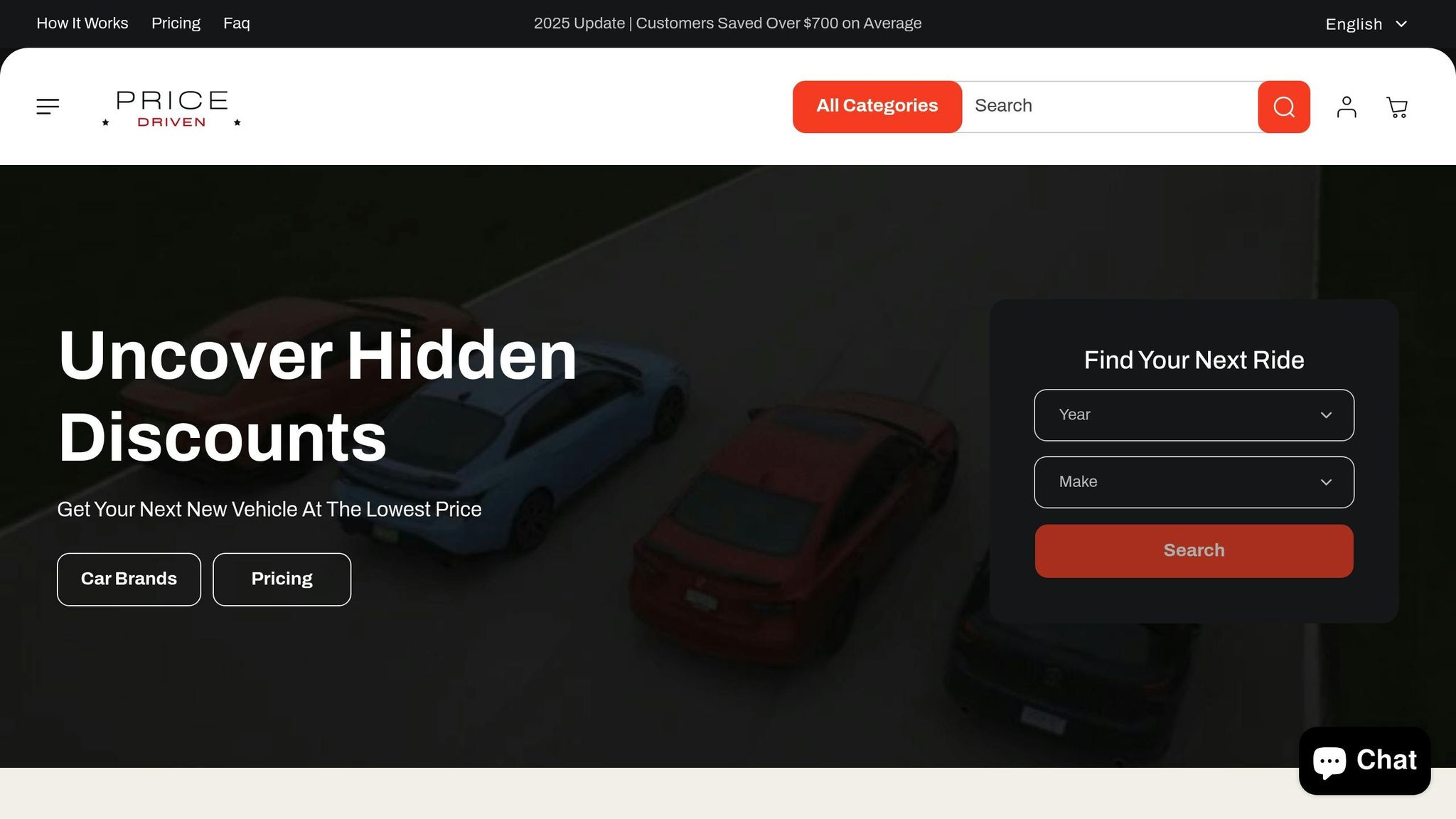
Price Driven takes the guesswork out of the process by offering insights into the dealer’s actual costs, including hidden incentives and factory discounts. Their free discount reports reveal dealer-level pricing, and pre-negotiated guaranteed prices remove the need for time-consuming haggling. In April 2025, users like Lucas H from London, ON, and Michael S from Vancouver, BC, shared how the platform helped them save money and reduce stress during their car-buying experience.
"The transparent pricing provided confidence, and the pre-negotiated deal saved me hundreds of dollars." – Lucas H, London, ON
"Knowing how much discount there is, helps with negotiating the price." – Michael S, Vancouver, BC
On average, customers reported saving over $700, with 28 out of 32 users in April 2025 expressing satisfaction with their final negotiated price. This transparency makes it easier to stick to your negotiation strategy and avoid overpaying.
Getting and Comparing Full Cost Breakdowns
Once you’ve gathered transparent pricing data, take the next step by requesting itemized quotes from dealerships. These quotes should include the base price, dealer fees, taxes, and any additional charges. Having a detailed breakdown allows you to compare offers side by side, spot inconsistencies, and identify unnecessary fees.
Pay close attention to standard dealer fees like documentation fees, tire stewardship fees, air conditioning excise tax, and administration fees. Some of these, such as air conditioning taxes or tire stewardship fees, are mandatory, while others might be negotiable or even waived. Always ask for clarification on which fees are legally required and which ones are simply added for profit.
Before making a final decision, get everything in writing and question any unclear charges. For added peace of mind, consult organizations like the Ontario Motor Vehicle Industry Council (OMVIC) or the Automobile Protection Association (APA). They can help you distinguish between legitimate fees and those designed to pad dealership profits.
Finally, compare out-the-door prices to ensure you fully understand your total cost before signing on the dotted line.
Conclusion
Grasping the difference between the invoice price and dealer fees gives Canadian car buyers a stronger position when making purchase decisions. The invoice price reflects what the dealer pays the manufacturer, while dealer fees are additional charges that can significantly impact the final cost of your vehicle. Together, these two factors shape the total price you’ll pay for your new car.
Key Points Summary
Here’s a quick recap of the essentials:
- The invoice price is a great starting point for negotiations.
- Dealer fees typically range from $300 to $800 or more, depending on the dealership and province.
- Some fees, like government-mandated charges (e.g., tire stewardship fees), are fixed and non-negotiable. Others, such as administration or documentation fees, often have room for negotiation.
To illustrate, consider a car with an invoice price of $28,000 and $1,200 in dealer fees. This sets the starting price at $29,200 before taxes. However, negotiating those fees down to $600 could lower your total cost to $28,600. That’s a clear example of how understanding these costs can lead to savings.
Making Informed Car Buying Decisions
Do your homework on both invoice pricing and dealer fees to avoid unexpected costs and negotiate effectively. Always request an itemized quote and don’t hesitate to question charges that seem excessive.
Platforms like Price Driven simplify this process by offering transparent access to dealer-level pricing, including hidden manufacturer incentives. In April 2025, 28 out of 32 users reported satisfaction with their final negotiated price, and customers saved an average of over $700 by leveraging this information.
With a clear understanding of invoice pricing and dealer fees, you’ll be well-prepared to make confident decisions on your next car purchase. Breaking down costs this way ensures you can secure a fair deal in Canada’s automotive market.
FAQs
What are dealer fees, and how can I tell which ones are negotiable when buying a car in Canada?
Dealer fees are extra charges that dealerships tack onto the car's purchase price. These can include required costs like freight and pre-delivery inspection (PDI), along with optional or negotiable fees such as documentation or administration charges.
To figure out which fees you might be able to negotiate, take a close look at the dealership's detailed cost breakdown. Fees like government taxes or licensing are usually fixed and non-negotiable. On the other hand, charges for extended warranties, dealer add-ons, or administrative services might be up for discussion. Always ask for a clear explanation of each fee and whether there's room to adjust or remove it.
How can I use the invoice price and dealer incentives to negotiate a better car deal?
To negotiate effectively when buying a vehicle, start by familiarizing yourself with the invoice price - this is what the dealership pays the manufacturer for the car. Knowing this gives you a solid starting point to gauge how much room there might be to negotiate. On top of that, ask about hidden dealer incentives, like manufacturer rebates or volume bonuses. These can reduce the dealer's actual costs and provide you with more bargaining power.
When you're at the negotiation table, refer to the invoice price and ask directly about any available incentives. Stay polite but assertive, aiming for a deal that feels fair for both sides. If you want extra confidence and clarity, platforms like Price Driven can help. They provide access to invoice pricing and pre-negotiated deals with dealerships across Canada.
How do market conditions impact invoice pricing and the ability to negotiate dealer fees?
Market trends significantly influence how flexible invoice pricing can be and whether there’s room to negotiate dealer fees. In a buyer’s market - when vehicle demand is low - dealerships are often more open to offering discounts or cutting extra fees just to close a deal. On the flip side, in a seller’s market, where demand is high and inventory is tight, snagging meaningful discounts becomes much harder.
Knowing how these market shifts work can give you an edge when planning your negotiation approach. Using tools that offer clear invoice pricing and access to pre-negotiated deals can make the process smoother, helping you make smart, well-informed choices no matter the market conditions.














































































